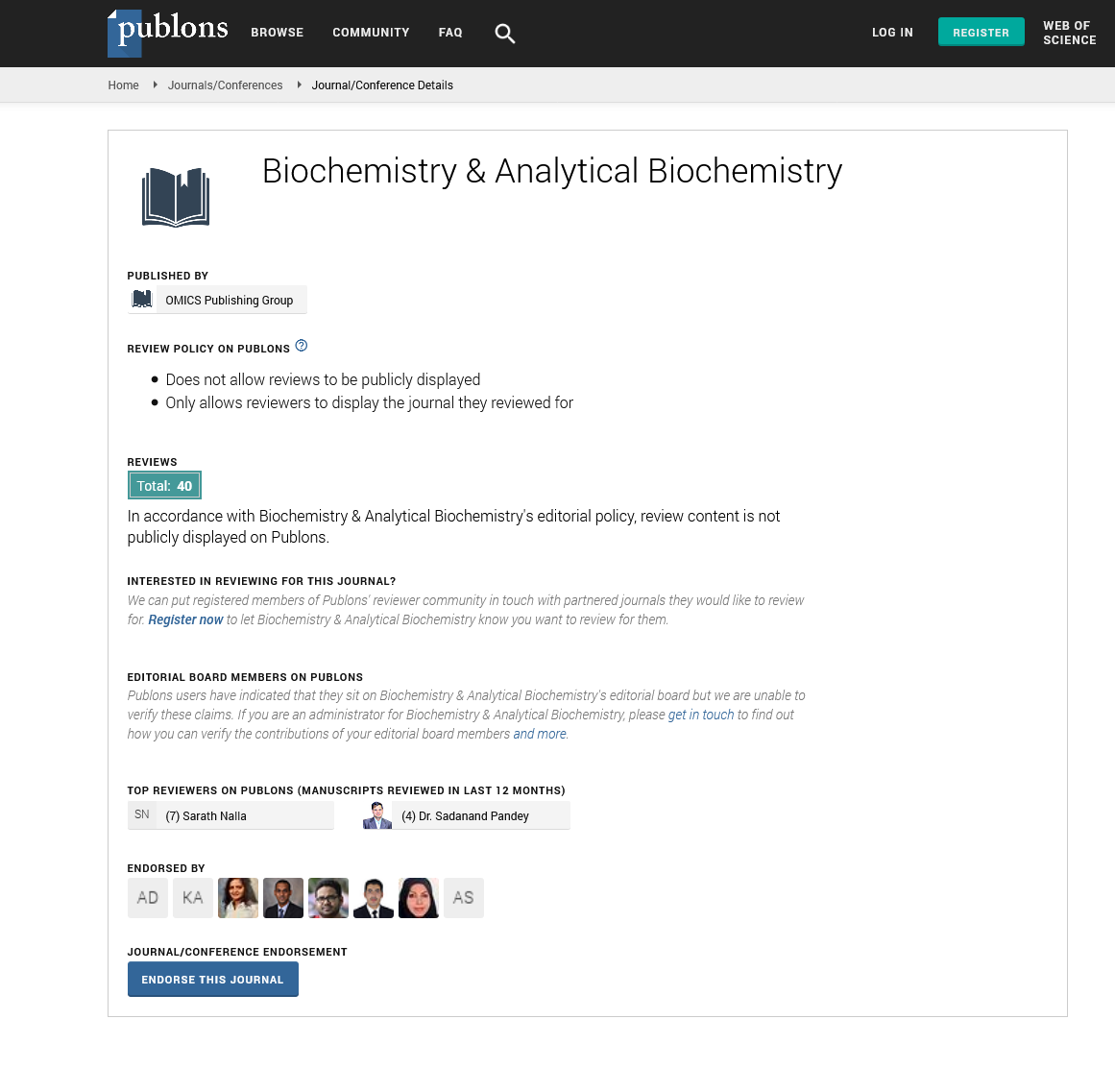Indexed In
- Open J Gate
- Genamics JournalSeek
- ResearchBible
- RefSeek
- Directory of Research Journal Indexing (DRJI)
- Hamdard University
- EBSCO A-Z
- OCLC- WorldCat
- Scholarsteer
- Publons
- MIAR
- Euro Pub
- Google Scholar
Useful Links
Share This Page
Journal Flyer

Open Access Journals
- Agri and Aquaculture
- Biochemistry
- Bioinformatics & Systems Biology
- Business & Management
- Chemistry
- Clinical Sciences
- Engineering
- Food & Nutrition
- General Science
- Genetics & Molecular Biology
- Immunology & Microbiology
- Medical Sciences
- Neuroscience & Psychology
- Nursing & Health Care
- Pharmaceutical Sciences
Short Communication - (2022) Volume 11, Issue 5
Protein Engineering and Its Strategies
Bhishem Thakur*Received: 03-May-2022, Manuscript No. BABCR-22-16877; Editor assigned: 05-May-2022, Pre QC No. BABCR-22-16877(PQ); Reviewed: 19-May-2022, QC No. BABCR-22-16877; Revised: 27-May-2022, Manuscript No. BABCR-22-16877(R); Published: 04-Jun-2022, DOI: 10.35248/2161-1009-22.11.431.
About the Study
Protein engineering is a field of recombinant DNA technology with a lot of initiating hot zones, where gene management is expressed as changes in protein structure that cause desirable features. Various strategies for specifically engineering proteins can primarily be characterized as techniques that necessitate a thorough understanding of the protein, establishing the concept of a logical technique of directed evolution that aids in the manifestation of natural evolution's progression [1]. Protein engineering has thrived in the previous to generate proteins that have beneficial uses in industry, health and pharmaceutical sciences, and, in the current scenario, Nano biotechnology.
To expedite the design and uses of enzymes, protein engineers are increasingly able to rely on structure-function insights, computational approaches, and a clearer understanding of natural biosynthetic processes. Protein engineering, or the manipulation of natural enzymes and proteins, is becoming a more relevant scientific field [2]. Protein modification will be efficient and simple thanks to well-known methods such as rational design and directed evolution, as well as new techniques. De novo engineering of enzymes, as well as new fields of protein engineering, will require new technologies such as computational design, catalytic antibodies, and mRNA display.
Peptides are a promising source of new therapeutics, but the biophysical characteristics of natural peptides, including their stability and propensity to aggregate, can limit their success. Protein engineering offers powerful tools to improve the properties of peptides for biological applications. In this review, we explain rational design, directed evolution, and computational methods and how these methods can be applied to improving the characteristics of peptides. Protein engineering has a wide range of medical uses. Protein engineering as a tool for cancer treatment research is a hot topic. The use of pretargeted radio immunotherapy as a cancer treatment has been discussed. Radiation toxicity is reduced by isolating the rapidlyremoved radionuclide from the long-circulating antibody through pretargeting [3].
The use of pretargeted radio immunotherapy was predicted to rise as protein engineering and recombinant DNA technology advanced. The ability of antibodies to select antigens selectively and with high affinity is used in the usage of new antibodies as anticancer medicines, and protein engineering approaches are employed to change antibodies to target cancer cells for clinical applications.
For potential cancer therapeutics, the phrase modular protein engineering has recently been coined. Targeted nano conjugates that are specifically directed against target cells are becoming more essential treatment options [4]. Protein engineering can also be used to create multifunctional and smart drug vehicles at the nanoscale. To identify and select targets for protein-based medication delivery, these methodologies could be combined. Protein engineering applications for therapeutic protein production are a growing field, especially in medicine. The synthesis of recombinant proteins for medicinal applications was examined in 1996. Protein engineering, it was asserted, resulted in a second generation of therapeutic protein products with application-specific features gained through mutation and fusion deletion [5,6].
Conclusion
To describe the third generation of such products, they were referred to as gene therapy protein products. The current version of these products was described as gene therapy protein products that patients would make after receiving a gene transfer. Singlechain designs for protein, cell, and gene therapy are among the other investigations on therapeutic protein production. Development of secreted proteins such as insulin, interferon, and erythropoietin as bio therapeutics agents, combinatorial protein biochemistry for therapeutics and proteomics, mega nucleases and DNA double-strand break-induced recombination for gene therapy, protein cationization techniques for future drug discovery and development, protein display scaffolds for protein engineering.
REFERENCES
- Elixhauser A. Costs of breast cancer and the cost-effectiveness of breast cancer screening. Int J Technol Assess Health Care. 1991;7(4):604-615.
[CrossRef] [Google Scholar] [PubMed]
- Howell A. Clinical evidence for the involvement of oestrogen in the development and progression of breast cancer. Proc Royal Soc B sci. 1989;95(1):49-57.
- Duan XN, Bai WP. China consensus on the safety management of endometrial endometrium in patients with breast cancer treated with selective estrogen receptor modulators. J Biomed Res. 2021;42(4): 672-677.
- Cao J, Huang M, Yan J, XU J, Yang Z, Huang K, et al. Effect of acupuncture on ER and PR expressions in rats with DMBA-induced mammary cancer. J Tradit Chin Med. 2016;35(3):344-348.
- Qi Y. Experimental study on NDVI inversion using GPS-R remote sensing based on BP neural network. Xuzhou: China University of Mining and Technology. 2018.
- Ma B, Yan G, Chai B, Hou X. XGBLC: An improved survival prediction model based on XGBoost. Bioinformatics. 2021.
Citation: Thakur B (2022) Protein Engineering and Its Strategies. Biochem Anal Biochem. 11:431.
Copyright: © 2022 Thakur B. This is an open access article distributed under the terms of the Creative Commons Attribution License, which permits unrestricted use, distribution, and reproduction in any medium, provided the original author and source are credited.

